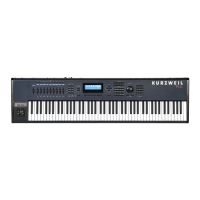Startup in Detail
How the PC3A Works
page 15
How the PC3A Works
The PC3A integrates three MIDI-driven components:
• a MIDI controller (the keyboard, or an external MIDI controller)
• a sound engine
• and an eects processor that employs the same eects used in Kurzweil’s KSP8.
The sound engine responds to the MIDI events generated by the MIDI controller, and turns them
into sounds that are processed within the variable architecture of the algorithms—or by
oscillators for KB3 programs. The resulting sound can then be routed through the PC3A’s eects
and to the audio outputs.
Operating Modes
The PC3A is always in one of eight primary operating modes.
Program mode Select and play programs, and modify them with the Program Editor.
Setup mode Select and play setups (16 keyboard zones with independent MIDI
channel, program and control assignments), and modify them with the
Setup Editor.
Quick Access mode Select from a list of preset banks, each containing a list of ten programs
and/or setups that can be viewed in the display for easy selection. Modify
the preset banks and create your own with the Quick Access Editor.
Eect mode Enable/disable eects or set Aux overrides for Program Mode (or a
program selected from Quick Access mode.)
MIDI mode Dene how your PC3A sends and receives MIDI information, and
congure each channel to receive independent program, volume, and pan
messages that override the normal Program mode settings.
Master mode Dene performance and control characteristics for the entire PC3A.
Song mode Use the PC3A’s sequencer to record and play back your keyboard
performance, play Type 0 and Type 1 MIDI sequences, and record multi-
timbral sequences received via MIDI.
Storage mode Interface with the PC3A’s USB storage or computer ports to load and save
programs, setups, and more.
The PC3A’s tone wheel organ emulation is called KB3 mode. You automatically enter this mode
when you select a KB3 program. The KB3 Bank button takes you there directly.
Consult the PC3A Musician’s Guide for more detailed descriptions of the modes.
VAST Synthesis
The PC3A’s Variable Architecture Synthesis Technology (V.A.S.T.) lets you build sounds from
realistic instrumental samples and sampled synth waveforms—then modify the nature of those
sounds through a wide variety of digital signal-processing (DSP) functions. The PC3A also
generates its own synth waveforms, which can be combined with the samples or used on their
own. The PC3A’s Variable Architecture lets you arrange a combination of DSP functions from a
long list of choices. The functions you choose dene the type of synthesis you use.

